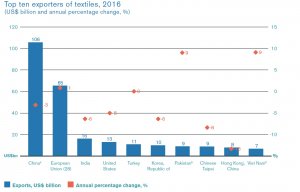Turkey and China continue to dominate EU socks imports
Industry Talk
Price hikes hit US and EU textile and clothing imports
US and EU textile and clothing import prices rose sharply in 2011 reflecting hikes in raw material prices, according to the latest Textile Outlook International reports from the global business information company Textiles Intelligence.

4th May 2012
Knitting Industry
|
Manchester
 US and EU textile and clothing import prices rose sharply in 2011 reflecting hikes in raw material prices, according to the latest Textile Outlook International reports from the global business information company Textiles Intelligence.
US and EU textile and clothing import prices rose sharply in 2011 reflecting hikes in raw material prices, according to the latest Textile Outlook International reports from the global business information company Textiles Intelligence.
Between March 2009 and March 2011 the average cotton price rose by 346% while the global price index for synthetics - a weighted basket of prices of acrylic, nylon, polyester and polypropylene fibres - rose by 71%. Since then prices have declined, but in January 2012 they were still well above the levels seen in March 2009.
Reflecting these rises, suppliers of textiles and clothing to the EU were forced to raise - or took advantage of the situation by raising - their prices by an average of 9.2% in 2011, from Euro 8.16 per kg to Euro 8.91 per kg. Furthermore, in terms of US dollars, the price increased by an even faster 14.6%, from US$ 10.81 per kg to US$ 12.39 per kg.
Recovery snuffed out
The effect was to almost snuff out the recovery in the market which had been welcomed in 2010 following recession in the previous year. In volume terms, EU imports from non-EU countries rose by only 0.5% in 2011 after they had grown by 9.0% in 2010.
In the US market, the effect of the price hikes was even more dramatic. In 2011 the average price of US textile and clothing imports rose by 12.2% to US$1.89 per sme - its highest level since 2001.
However, whereas EU imports rose marginally in volume terms, there was a significant reversal in the USA as imports fell in volume by 3.2% after growing by 19.0% in the previous year.
The average price of EU textile and clothing exports also rose significantly during the year. In fact, it was up by as much as 13.7%.
Forward prices
Reflecting this, it is not surprising that one of the major topics of conversation at recent European yarn fairs was the high cost of raw materials, particularly cotton and wool. Indeed, spinners and fabric manufacturers were finding it difficult to give forward prices for their products because of the volatility of cotton prices, and this resulted in an increase in interest in linen and viscose.
Interest in substitute fibres was already apparent in US imports in 2011. The increase in the average import price was stronger in the case of cotton apparel than in apparel made from other fibres and these price differentials were reflected in import volumes. In the case of cotton apparel, imports fell by 10.2% as buyers were put off by higher prices. By contrast, imports of man-made fibre apparel rose by 14.9%.
As spinners await news of the 2011/12 cotton crop, the future of the raw cotton market remains uncertain. Although the extreme price volatility witnessed in 2009-11 has moderated, price volatility may be something which the fibre, textile and clothing industry will have to live with for the foreseeable future.
The latest issue of Textile Outlook International includes the following reports, which can be purchased in PDF format by following the links:
World Textile and Apparel Trade and Production Trends: the EU
Survey of the European Yarn Fairs for Spring/Summer 2013
Prospects for the Textile and Clothing Industry in Indonesia

Business intelligence for the fibre, textiles and apparel industries: technologies, innovations, markets, investments, trade policy, sourcing, strategy...
Find out more


-300x192-cropped.jpg)










